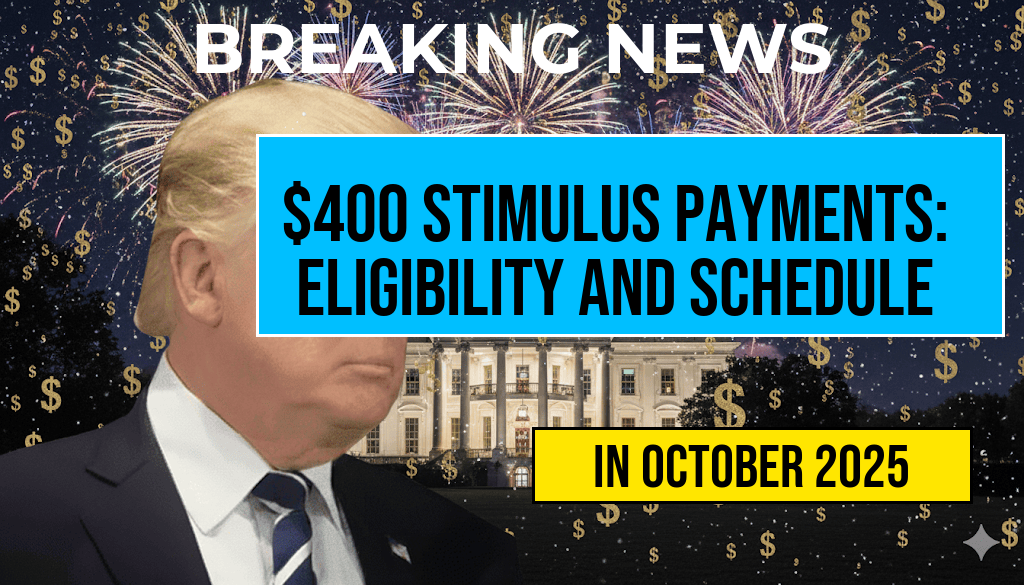As the economic landscape continues to fluctuate, many Americans are looking towards potential financial relief measures from the government. Recently, discussions surrounding a new round of $400 stimulus payments have gained momentum, aiming to assist those impacted by ongoing economic challenges. This guide will provide clarity on the eligibility criteria for these payments, as well as the anticipated payment schedule. Understanding these elements is crucial for individuals and families who may benefit from this financial support.
Eligibility Criteria for $400 Stimulus Payments
The eligibility for the $400 stimulus payments is primarily based on income levels and specific circumstances of applicants. Below are the key factors that determine who qualifies:
- Income Level: Individuals with an annual income below $75,000 and couples filing jointly with an income under $150,000 are generally eligible.
- Dependent Status: Households with dependents may receive additional payments, expanding the financial assistance for families.
- Citizenship Requirement: Applicants must be U.S. citizens or legal residents to qualify for the stimulus payment.
- Previous Payments: Those who received prior stimulus payments are likely to qualify again, provided they meet the current income requirements.
Additional Considerations
Some states have proposed their own stimulus plans, which may differ from federal guidelines. For example, certain states are considering state-specific programs that could provide additional funds based on local economic conditions and budgets. Residents should check their state’s official website for precise details.
Payment Schedule
The timeline for disbursement of the $400 stimulus payments is still being finalized. However, here is what is currently known:
| Payment Phase | Estimated Date |
|---|---|
| Initial Payments | March 2024 |
| Subsequent Payments | June 2024 |
| Final Payments | September 2024 |
These dates are subject to change based on legislative processes and budget approvals. Recipients are encouraged to stay informed through official government announcements.
How to Apply
Applying for the $400 stimulus payment will typically involve filling out a form through the IRS or your state’s tax agency. Here’s a general outline of the process:
- Gather Documentation: Collect your tax returns, proof of income, and any relevant identification.
- Complete Application: Fill out the necessary forms online or by mail as directed by the IRS.
- Submit Application: Ensure that your application is submitted before the deadline to avoid missing out on the payment.
- Check Status: Utilize the IRS website to track the status of your application and payment.
Resources for Further Information
Individuals seeking more information about the stimulus payments can refer to the following reputable sources:
As discussions around economic relief continue, staying informed can empower individuals and families to take advantage of available resources. Understanding the eligibility criteria and payment schedule for the $400 stimulus payments is a critical step towards accessing much-needed financial support.
Frequently Asked Questions
What are the eligibility criteria for the $400 stimulus payments?
To qualify for the $400 stimulus payments, applicants must meet specific income thresholds and residency requirements, which may vary by state. Generally, individuals who earn below a certain income level and are legal residents can apply.
When will the $400 stimulus payments be distributed?
The payment schedule for the $400 stimulus payments varies by state, but most payments are expected to be disbursed in several phases throughout the year. It is advisable to check with local government websites for exact dates.
How can I apply for the $400 stimulus payment?
Eligible individuals can apply for the $400 stimulus payment through their state’s designated application process, which may include online forms or in-person visits to local offices. Make sure to have all required documentation ready to expedite the process.
Will I need to repay the $400 stimulus payment?
No, the $400 stimulus payment is considered a grant and does not need to be repaid, as long as the recipient meets all eligibility criteria. However, recipients should keep records in case of future inquiries.
What should I do if I haven’t received my $400 stimulus payment?
If you have not received your $400 stimulus payment within the expected time frame, you should contact your local government’s financial assistance office or check their website for any updates regarding your payment status.

Leave a Reply